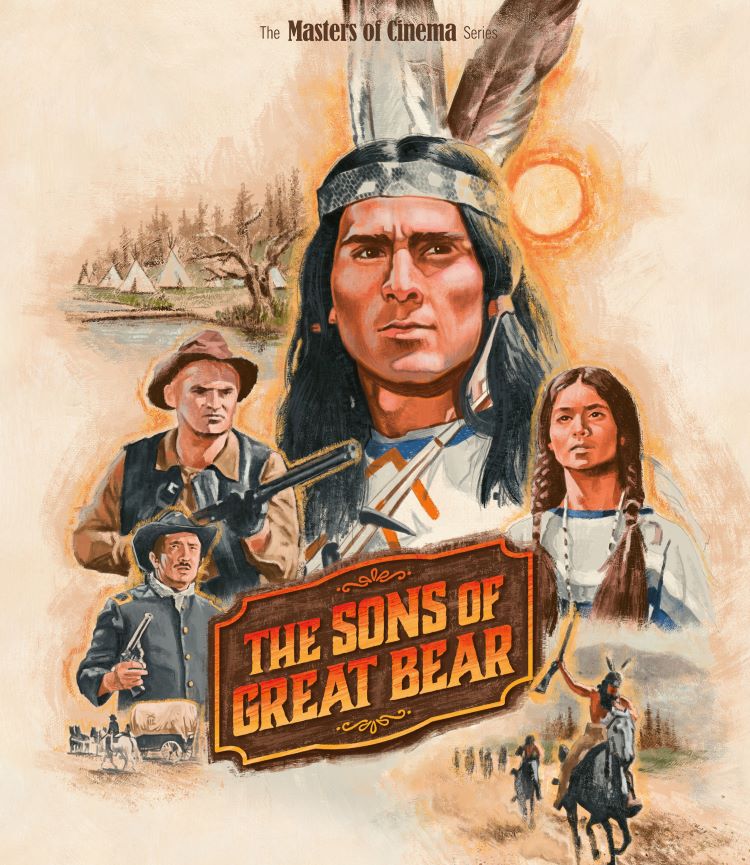Westerns had long been popular with German cinema audiences, some of the most successful being early 1960s West German adaptations of novels by Karl May, a slippery late-19th writer whose books were hugely admired by Hitler. East Germany’s state-run studio DEFA responded by producing The Sons of Great Bear (Die Söhne der großen Bärin) in 1966, the first of East Germany’s "Indianerfilme".
Offering an alternative, anti-imperialist take on the American frontier myth, producer Hans Malich explained that DEFA’s film would portray white settlers as oppressors, Native Americans (still referred to as "Indians" back then) as “heroes who can serve as role models because of their courage, will to fight, and love for their people”.
 Rather than use a scenario by the ideologically suspect May, Malich and director Josef Mach chose to adapt a popular novel by Liselotte Welskopf-Henrich, a historian and novelist with first-hand experience of Native American culture (she dismissed May’s books as “irresponsible fabulations”). She wrote her own screenplay, claiming that it was based on real events. Like many DEFA epics, this was a co-production with other Eastern Bloc film studios: Mach and principal villain Jiří Vršťala were Czech, leading man Gojko Mitić was born in Serbia. Location shooting took place in Yugoslavia, Czechoslovakia and East Germany. It’s a heady mix.
Rather than use a scenario by the ideologically suspect May, Malich and director Josef Mach chose to adapt a popular novel by Liselotte Welskopf-Henrich, a historian and novelist with first-hand experience of Native American culture (she dismissed May’s books as “irresponsible fabulations”). She wrote her own screenplay, claiming that it was based on real events. Like many DEFA epics, this was a co-production with other Eastern Bloc film studios: Mach and principal villain Jiří Vršťala were Czech, leading man Gojko Mitić was born in Serbia. Location shooting took place in Yugoslavia, Czechoslovakia and East Germany. It’s a heady mix.
Watch certain scenes with subtitles and sound switched off, and you’d swear you were looking at an out take from a John Ford or Howard Hawks original, the early raid on a wagon train replaying a famous sequence from Ford’s Stagecoach and doing it brilliantly. Set in 1874 against a background of colonial expansion, the brutality of the Europeans is established within minutes when Vršťala’s Red Fox stabs an Oglala Dakota elder for refusing to reveal the source of the gold he carries in his purse. As shocking as the murder is the complete indifference shown by the other drinkers in the saloon, Brigitte Krause’s brassy hostess as cynical and dishonest as the schlubs she’s serving.
Watching the killing is the charismatic young warrior Tokei-ihto (Mitić). He and his people face a bleak future as long as the white settlers are “spreading like a prairie fire”, the only option on offer being to settle in a reservation. This being 1966, the Oglala Dakota characters are portrayed by white Europeans in brownface makeup rather than indigenous actors; if you can get past that, there’s much to enjoy and admire here. Mach and set designer Paul Lehman’s vision of Dakota life is idyllic, a calm, well-organised society with all members playing their part, important decisions made by a council of wise elders. It’s in stark contrast to the settlers’ lifestyles, their choices fuelled by self-interest and alcohol. The pace flags in several scenes, the screenplay often too talky for its own good, but the final battle between Tokei-ihto and Red Fox is brilliantly staged.
This 2K restoration looks impressive, and there’s the option to watch with a commentary from film historian Jenny Barrett. Mariana Ivanova’s booklet essay is an interesting read, do look at Austin Fisher’s brief video essay, especially interesting when comparing the "Red Western" genre with examples made in Italy and Spain. A real curio, then, but a fascinating one.













Add comment